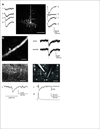Two-photon optogenetics of dendritic spines and neural circuits
- PMID: 23142873
- PMCID: PMC3518588
- DOI: 10.1038/nmeth.2249
Two-photon optogenetics of dendritic spines and neural circuits
Abstract
We demonstrate a two-photon optogenetic method that generates action potentials in neurons with single-cell precision, using the red-shifted opsin C1V1(T). We applied the method to optically map synaptic circuits in mouse neocortical brain slices and to activate small dendritic regions and individual spines. Using a spatial light modulator, we split the laser beam onto several neurons and performed simultaneous optogenetic activation of selected neurons in three dimensions.
Figures



References
Publication types
MeSH terms
Substances
Grants and funding
LinkOut - more resources
Full Text Sources
Other Literature Sources

